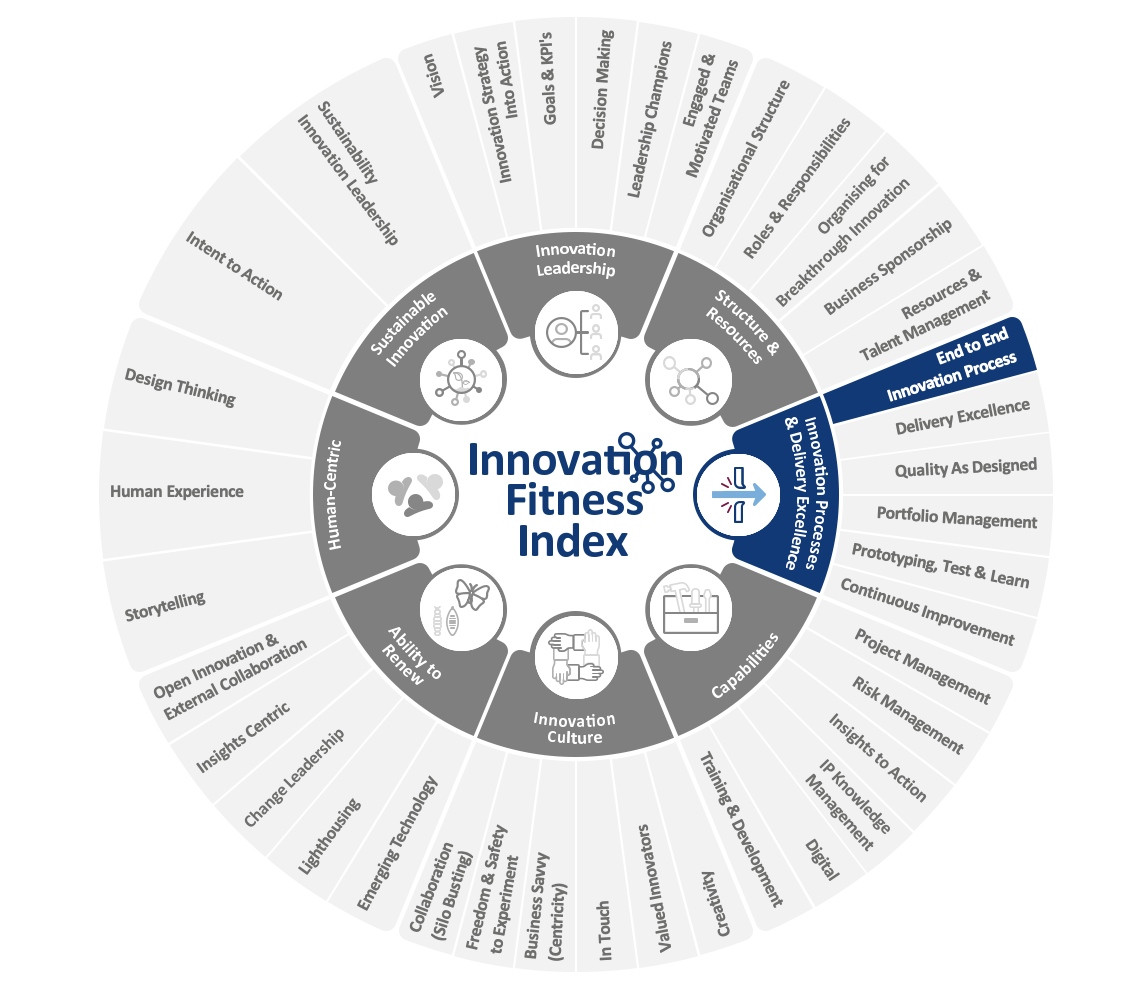The key to sustained growth relies on an ability to innovate reliably and sustainably. At Skarbek, we are embarking on a journey to unravel the mystery behind what makes the best excel at this. Leveraging our experts’ vast experience and highlighting attributes from our Innovation Fitness Index, we aim to provide unique insights into some of the core factors impacting innovation success. Today’s article is focused on the specific Innovation Fitness Index attribute “End to end innovation processes”, looking to uncover some of the key factors in innovation management processes that specifically enable Speed and Agility, while preserving the excellence in delivery.
How can organisations accelerate the pace of innovation and increase operational agility, all whilst preserving rigour in delivery? Many of our clients face the same challenge in universally fast-changing market environments and fast-shifting consumer / user expectations. Rare are the business leaders that tell us they are satisfied with how reactive their innovation engine is to respond to the speed of market needs. A common misconception often heard is that processes and rigour go against agility and speed. Should all processes be burnt away in sacrifice to the gods of agility? We think not!
Most of our clients operate with end-to-end processes, systems and tools with varying degrees of sophistication. Although rarely perfect, most processes and set-ups work in low to mid pressure environments, where operational buffers exist to absorb inefficiencies. This is often not the case anymore when put under significant pressure with a high volume of initiatives, increased expectations for speed, in often under-resourced environments. Under these circumstances, non-optimal operational models show their limits, eventually constraining speed and ability to respond to changes with agility.
“The Fast and Innovative companies perform much better — respectively 9.8 and 11.6 percentage points higher on net profit margin and revenue growth compared to industry averages” – MIT research (Apr 2023)
What are some of the key factors affecting the ability of an organisation to increase the speed and agility of its innovation process, whilst protecting expected rigour in delivery? And what can you do about it? Here are some starter tips of where to look first:
Do you have well trained conductors to your multi-functional orchestra?
One of the most common reasons for lack of speed and agility in an innovation process is the absence or under-developed capability in Project Management. A trained Project Manager (PM) leads project end-to-end with accountability, adapts to changing context, ensures the right decisions are taken at the right time, ensures the ball moves up-field and never loses track of the scoring line. Our experience shows that even in the context of inefficient processes and systems, a high capability PM is able to lead projects to resounding success. Building PM capacity and capability is often the best capability building choice an organisation can make to increase operational speed and agility.
Are you focused on your top priorities?
Innovation initiative portfolios are often very busy, driven by ungoverned activity proliferations. As a consequence, the demand for resources invariably stretches teams beyond anyone’s ability to lead execution with excellence. Small and complex initiatives are often demanding the same (or more!) resources than blockbuster initiatives. An ability to make choices is absolutely critical to right size initiative portfolio, control proliferation of activities and at all times ensure priorities are clear and enabled first. Developing the right mechanisms to capture and characterise enabling data (resources, demand, initiatives complexity, etc), as well as creating the right governance forums with clear decision-making responsibilities, is essential to enable this critical operational capability.
Are humans at the core of your processes?
Processes, systems and tools are critical enablers to an innovation process. Humans need to lead them, not be led by them. An over-reliance on standards and automated processes can be highly counter-productive when humans are not at the core of the engine, actively breaking down functional silos and enabling the critical conversations that enable smart decision making, agility, and recognising the unique nature of each project. In extreme cases, organisations leverage workflow-based IT platforms to instruct functions and coordinate projects. While this approach can add efficiency in highly standard processes (e.g. artwork management), in end-to-end management of innovation they invariably lead to breakdown in communication, rationale thought processing and reactive decision making. Intentionally fostering human cross-functional communication is critical for any innovation process to operate at its best.
Is your stage gate process enabling the right decisions?
Most organisations have rightly adopted a stage gate approach to initiative governance. Significantly less organisations operate it in its intended spirit, where gates are critical data-enabled decision points that check that projects meet the right conditions to be progressed (possibly taking documented and mitigated risk), or justify the need to be reworked or killed. More often than not decisions are not made at gates, or are made with missing data, and projects progress regardless with incomplete readiness, ultimately leading to mounting inefficiencies, risks and invariably leading to late and costly surprises. Enabling interventions include:
- Revisiting portfolio and initiative governance models, including the role of an Innovation Management Board in reviewing initiative readiness and making clear decisions
- Enforcing high quality gate preparation from project teams (via the Project Manager) to ensure that the appropriate readiness data is available at every gate and presented in a standardised manner
- Increasing the rigour of portfolio reviews, establishing routines and making gate governance and decision making a second nature in your organisation
Are your processes right-sized to your needs?
Simplification should be an area of focus for all organisations. Starter thoughts:
- Re-think your activity flow – Is there a better way to get from point A to B? Processes and end-to-end workflow benefit from being revisited on a regular basis. Has the context changed? Do we need to sequence the work like we currently do, or can we parallelise some activities? Are the right factors involved at the right time? At Skarbek, we often accompany clients in revisiting their cross-functional processes through Integrated Planning Sessions, an engaging co-creative process looking to design the most efficient paths to deliver initiatives from start to finish.
- Simplify the gate process – A train travelling from London to Glasgow will get to a destination faster if it stops 3 times on the way than if it stops 7! Process gates need to exist for a reason, which is to make a conscious decision driven by multiple factors. If no decision is required and a project moves forward anyway, don’t constrain it. The minimum number of gates you can operate with, the best.
- Constrain the WHAT, not the HOW – Rigorous innovation processes make clear WHAT needs to be delivered, and measure readiness at key points in time. How projects progress between these touchpoints should be significantly less constrained. This is where team agility can add most value, finding the best ways to move forward at pace, without compromising the intent and project deliverables.
Are you carrying risk for too long?
Achieving speed with a high degree of certainty is closely linked to how processes and ways of working are geared towards learning early and de-risking projects by anticipating what could go wrong (advancing mitigation and getting focused on achieving primary objectives as quickly as possible).
Speed, agility and rigour are not conflicting concepts. A complex set of factors affect that fine balance organisations want to achieve, moving at pace without negatively affecting their ability to deliver intent with excellence. Well-chosen interventions can make a significant impact. At Skarbek, we understand the holistic factors that uniquely affect an organisation’s ability to unlock new levels of effectiveness and have accompanied numerous clients through this journey of transformation. Get in touch with our industry specialists if you are looking for the keys to unlock your organisation’s innovation speed and agility.
We leverage hands-on industry experience and expertise to go beyond copy-paste concepts and help our clients design the operating model solutions that uniquely suit their needs. We then assist in piloting and activating novel operating models, and support project kick-offs to accelerate impact. This approach has seen our clients accelerate the progress of game-changing breakthrough innovation – a recent case study can be found here.
Want to learn more? Get in touch today to speak with one of our innovation experts – enquiries@skarbek.com | +44 1932 366 585
End to End Innovation Process is just one element of Skarbek’s Innovation Fitness Index, a holistic diagnostic tool, helping clients to assess how well their organisation is poised to drive innovation today. This powerful tool goes beyond conventional assessments, offering a comprehensive analysis of your organisation’s readiness to deliver innovation. It allows clients to unlock valuable insights that can shape strategy, enhance processes and elevate their innovation game.

